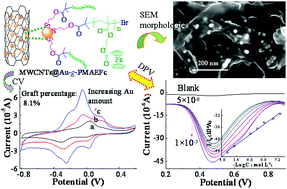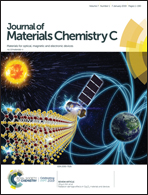Novel multi-walled carbon nanotubes decorated with gold nanoparticles with poly(2-methacryloyloxyethyl ferrocenecarboxylate) grafted on to form organic–inorganic nanohybrids: preparation, characterization, and electrochemical sensing applications†
Abstract
With the increasing development of science and technology, food analysis and detection techniques are continouosly being updated, consummated, and are booming. To meet the demands for high efficiency, speediness, and accuracy in food detection, new rapid detection technology needs to be developed for ensuring food safety and human heath. For this purpose, multi-walled carbon nanotubes decorated with gold nanoparticles-grafted poly(2-methacryloyloxyethyl ferrocenecarboxylate) (MWCNTs@Au-g-PMAEFc) nanohybrids were prepared through ATRP of MAEFc, with the MWCNTs@Au nanocomposites prepared via an in situ reduction route. The chemical structure and composition of the nanohybrids were characterized by 1H NMR, FTIR, Raman, XRD, TGA, UV-vis, and XPS techniques. The dispersion behavior and morphologies were investigated by UV-vis, TEM, and SEM observations. The electrochemical properties were studied by cyclic voltammetry (CV) and differential pulse voltammetry (DPV). The experimental results indicated that the nanohybrid-modified electrodes possessed clearly improved electrochemical properties and good reversibility of the redox process, which could be tuned by altering the composition proportions, including the mass ratios of MWCNTs to Au NPs, and the graft percentage of PMAEFc chain segments. The resultant modified electrode sensors could efficiently detect trace poisonous and harmful pesticide residues, and presented a good linear relationship between the concentration and the peak currents, giving a low limit of detection of about 2.7 × 10−8 mol L−1. The developed nanohybrids could therefore be fabricated into electrochemical sensors to detect trace pesticide for ensuring food safety.



 Please wait while we load your content...
Please wait while we load your content...